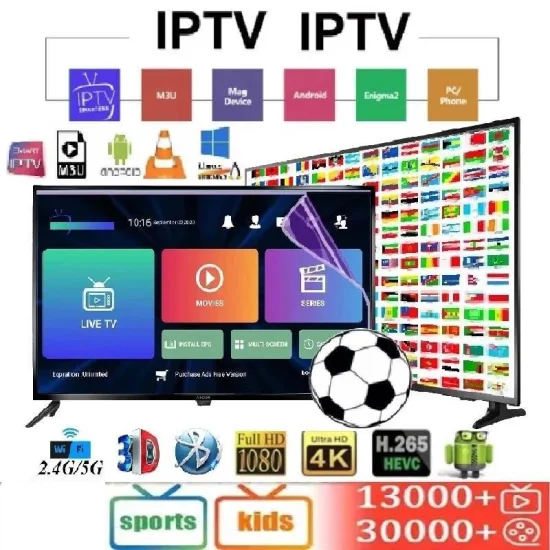Update Your Home Entertainment: Cost Effective IPTV Subscription Packages
Wiki Article
Just How IPTV Works: A Step-by-Step Guide to Web Protocol Television Modern Technology
Web Method Television (IPTV) has actually revolutionized the method we eat television web content, offering a brand-new world of possibilities with the power of the net. Understanding the ins and outs of how IPTV works can clarify the modern technology that drives this innovative type of media distribution. From the fundamental principles of IPTV to the complicated procedure of content shipment, each action plays a crucial function in making sure a smooth viewing experience. In this overview, we will certainly discover the hidden systems that make IPTV a remarkable combination of modern technology and enjoyment.IPTV Essentials
In recognizing IPTV essentials, it is crucial to realize the basic operations of this modern technology in supplying tv material over the web. IPTV, which means Web Protocol Television, makes use of Net Method (IP) networks to transfer television content to users' tools. Unlike typical approaches of transmitting television content via wire or satellite signals, IPTV streams media via high-speed web connections.
In addition, IPTV enables interactive abilities, such as video clip on need (VOD) and electronic program overviews (EPG), improving the user experience by giving even more control and flexibility in accessing web content. Generally, recognizing the essentials of IPTV establishes the foundation for discovering its more advanced capabilities and the advantages it provides to modern tv usage.
Web Content Distribution Process
Reliable material distribution in IPTV systems includes a well-structured procedure that makes sure seamless transmission of television web content over IP networks. The material distribution process in IPTV starts with the creation of the video clip content, which is after that inscribed into electronic format appropriate for IP transmission. This encoded material is after that securely kept on web servers known as media web servers. When a viewer demands particular content, the IPTV system obtains the asked for data from the media servers and supplies it to the viewer's gadget online.
Middleware Capability
With the combination of middleware, IPTV systems gain boosted performance that streamlines individual communication and material monitoring. One of the essential features of middleware in IPTV is to enable tailored user experiences by giving features such as interactive program overviews, video-on-demand services, interactive advertising and marketing, and individual choices management.
Device Compatibility
Provided the essential function of middleware in allowing seamless interaction and content management in IPTV systems, an essential aspect to consider is the compatibility of devices made use of for accessing the IPTV solutions. Gadget compatibility is vital for making sure a smooth individual experience and optimal performance when accessing IPTV web content.In the context of IPTV, tool compatibility refers to the ability of a device to this contact form properly engage with the IPTV service, display material appropriately, and support the necessary methods and codecs for streaming video clip material online. Various gadgets, such as smart Televisions, set-top boxes, smart devices, tablets, and computers, might have varying degrees of compatibility with IPTV solutions.
To guarantee a smooth viewing experience, it is essential for customers to select devices that work with the particular IPTV solution they are utilizing. Additionally, IPTV solution suppliers should supply support for a vast array of devices to accommodate the diverse demands of their individual base. By prioritizing tool compatibility, both individuals and provider can enhance the general IPTV experience.
Quality of Service (QoS)
Considering the important role of keeping a high requirement of efficiency and integrity in IPTV systems, guaranteeing constant Top quality of Solution (QoS) continues to be an essential facet of the customer experience. QoS in IPTV refers to the capacity of the system to deliver material with marginal disruptions, high resolution, and quick filling times. To achieve ideal QoS, numerous elements require to be resolved. Network bandwidth is vital to support premium video clip streaming without buffering or pixelation. In addition, latency, jitter, and packet loss should be decreased to boost the viewing experience.click for source
Provider use QoS systems such as web traffic prioritization, buffering, and error correction to maintain a steady IPTV solution. By focusing on IPTV web traffic over less time-sensitive data, providers can ensure smooth playback also throughout top usage hours. Buffering aids make up for network changes, while error correction strategies improve data integrity.
Continual surveillance and optimization of QoS specifications are important to adapt to transforming network conditions and customer needs. Ultimately, a durable QoS framework is vital for supplying a seamless and delightful IPTV experience to individuals.
Conclusion
In final thought, IPTV runs via the transmission of television material over net protocol networks. High quality of Solution plays a vital function in keeping the efficiency and dependability of IPTV solutions - IPTV subscription.Report this wiki page